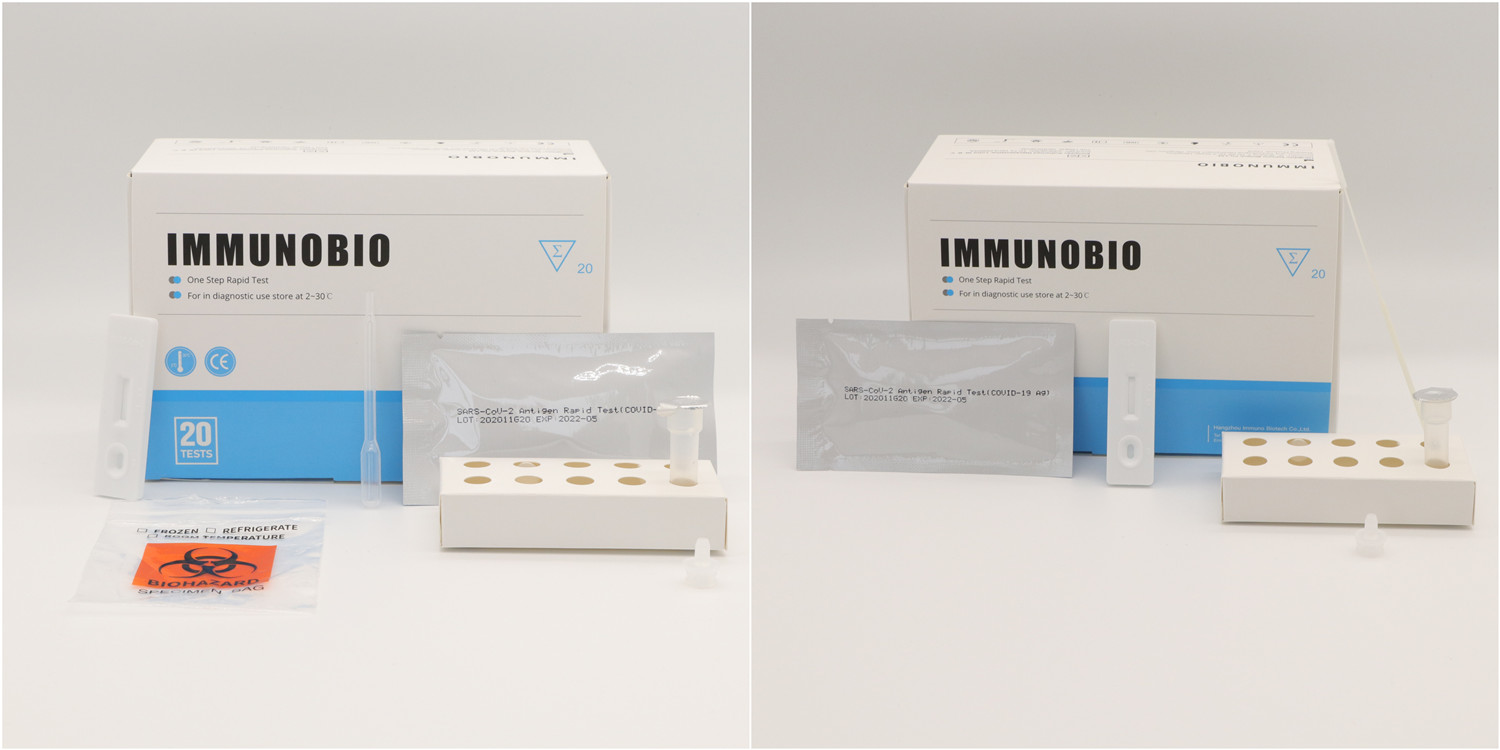PEI/Bfarm listed COVID Antigen Test Kit Antigen Nasal Swab/Saliva Rapid Test Kit Self Test
EI/Bfarm listed COVID Antigen Test Kit Antigen Nasal Swab/Saliva Rapid Test Kit Self Test
| Used For | COVID 19 Antigen Nasal Swab/Saliva Rapid Test Kit |
| Specimen | Nasal Swab or Saliva |
| Certification | CE/ISO13485/White List/PEI certified |
| MOQ | 1000 test kits |
| Delivery time | 1 week after Get payment |
| Packing | 1 test kits/Packing box5 test kits/packig box20 test kits/packing box |
| Test Data | Over 95% Sensitivity and Specificity |
| Shelf Life | 2 years |
| Production Capacity | 1 Million/Week |
| Payment | T/T, Western Union, Paypal |
SHORT INTRODUCTION
The SARS-CoV-2 antigen rapid detection kit is used to detect SARS-CoV-2 antigens.
Anti-sars – cov -2 monoclonal antibodies are encased in the detection line and connected to the colloidal gold couple.
During the test, the specimen reacts with the anti-sars-cov-2 antibody conjugate in the test strip.
The mixture then moves upward on the membrane through capillary tube action and reacts with another anti-sars-cov-2 monoclonal antibody in the test area.
The complex is captured and a colored line is formed in the test line area.
Sars-CoV-2 antigen rapid detection contains anti-SARS-CoV-2 monoclonal antibody conjugate particles, and another anti-SARS-CoV-2 monoclonal antibody is encased in the detection line area.
Features
A.High Sensitivity and Specificity
B. With PEI certified and Bfarm Listed
C. Fast deliverr
D. Applicable for nasal swab and Saliva collection Bag test
Authorized certifications
- CE/ISO13485
- White List
- PEI/Bfarm Listed
- ANMAT Authorization
STORAGE AND STABILITY
The kit can be stored at room temperature or refrigerated (2-30°C). The Test Strip is stable through the expiration date printed on the sealed pouch. The Test cassette must remain in the sealed pouch until use. DO NOT FREEZE. Do not use beyond the expiration date. The stability of the kit under these storage conditions is 18 months
SPECIMEN COLLECTION AND PREPARATION
The SARS-CoV-2 Antigen Rapid Test (COVID- 19 Ag) can be performed using nasopharyngeal or oropharynx swab, nasal swab and saliva.
Nasopharyngeal Swab: Insert the sterile swab into the deep nasal cavity until the nasopharynx. Gently rub and rotate the swab against wall of turbinate for several times.
Oropharynx Swab: Insert the sterile swab into the throat. Gently scrape the secretions around the wall of pharynx and tonsil.
Nasal Swab: Insert the sterile swab into one of the nostrils around 2.5cm. Gentally rub against the anterior nasal wall and repeat the actions into the other nostril.
Saliva: Prepare a specimen collection container. Make a “Kruuua” noise from the throat, to get out the saliva or sputum from the deep throat. Then spit saliva (about 1-2ml) into the container. Morning saliva is optimal for saliva collection. Do not brush the teeth, eat food or drink before collection the saliva specimen.
Take out of an assay buffer tube, and tear off the head of the tube. Extrude all the liquid (around 0.5ml) into a specimen collection tube.Insert the swab into the tube and squeeze the flexible tube to extrude the specimen from the head of the swab. Make the specimen resolved in the assay buffer sufficiently. Add the tip onto the specimen collection tube. If saliva specimen, suck the saliva from the container and place 5 drops (approx.200ul) of the saliva into the sample collection tube.
The assay should be performed immediately in 2 hours after the specimen preparation. If the assay could not be carrie immediately, the prepared specimen should be kept no more than 24 hours at 2-8°C or 7 days at -20°C.
Bring specimens to room temperature prior to testing. Frozen specimens must be completely thawed and mixed well prior to testing. Specimens should not be frozen and thawed repeatedly for more than two times. If specimens are to be shipped, they should be packed in compliance with federal regulations covering the transportation of etiologic agents.
SELF-TEST
Immunobio SARS-COV-2 Antigen Rapid Test Kit successfully registered as SELF-TESTS in Germany. The registration test results show that our products have excellent performance and are highly recognized by customers.
The BfArM provides a list of the antigen tests for the direct detection of pathogens of the coronavirus SARS-CoV-2, which are intended by the manufacturer for self-use.
Test Method
Allow the test kits, sample, buffer and/or controller to be balanced to room temperature (15-30 degrees C) prior to testing.
1.Leave the package at room temperature before opening it. Remove the test Kit from the sealed bag and use it as soon as possible.
2.Place the test kits on a clean level surface.Flip the specimen collection tube, squeeze the prepared specimen out of 3 drops into the specimen hole (S) of the test box, and start the timer.
See the instructions below.
- Wait for the colored line(s) to appear. Read results at 10 minutes. Do not interpret the result after 15 minutes.
INTERPRETATION OF RESULTS
-Positive sign: Two colored lines appear.
A colored line should always appear in the control line area (C) and the other line should appear in the T-line area.
Note: The color intensity of the test line area may vary depending on the concentration of SARS-CoV-2 in the sample, Therefore, shadows of any color in the test line area should be considered positive and recorded.
- Negative (-): A colored line appears in the control line area (C) and no lines appear in the T-line area.
- Invalid: Control lines cannot be displayed. Insufficient sample capacity or incorrect operating techniques are the most likely causes of control line failures.Review the process and repeat it with a new test. If the problem persists, stop using the test kit immediately and contact your local dealer.









